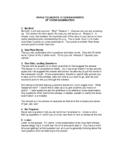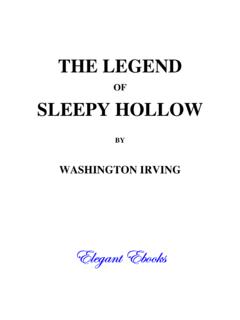Transcription of The Legend - Irving Arts Center
1 We Set the Stage for Learning Theatre IV, Richmond, VAIn the ClassroomTeacherResourcesTheatre IV s The Legend of Sleepy Hollow and the Classroom Connections Study Guide are produced in support of the teaching of states standards, as well as national standards set forth by the National Council of Teachers of English (NCTE).Activities provided support curriculum in grades K-5 On the WebThe following web sites have activities and information related to Washington Irving and The Legend of Sleepy recording of the Elementary Lesson Plan tied to National American Art on Washington K - 5At the LibraryChorpenning, Charlotte B. Rip Van Winkle; A Play for Young People from the Story by Washington Irving . Chicago, IL: Coach House Press, , Washington. The Legend of Sleepy Hollow and Rip Van Winkle. New York: Dover Publications, Inc.
2 , 1995. (in easy-to-read type)The Legend of Sleepy HollowScript, lyrics & music 1996 & 2006 by Paul Deiss; based on the story by Washington IrvingPlay Synopsis:Based on the original story by Washington Irving , The Legend of Sleepy Hol-low tells the story of Tarry Town, a place where strange things happen and the townsfolk seem entranced by spirits. Ichabod Crane, a well-educated teacher who comes to live in Tarry Town, meets a mysterious fate. Legend has it that he is the victim of the dreaded headless horseman who allegedly haunts Sleepy Hollow. Before his disappearance, Ichabod had been at a party at the home of Katrina Van Tassel, a young lady with whom Ichabod was much smitten. During the festivities, he was humiliated by Brom Van Brunt, Ichabod s egotistical rival. He is also frightened by tales of spirits and strange happenings in Tarry Town.
3 He left the party wondering whether he had been the target of a cruel joke by all of the partygoers. After his disappearance, his horse was found grazing in a nearby pasture. His hat was found trampled on the path, and the slimy remains of a pumpkin were found nearby. Whatever happened to Ichabod? No one knows for sure. Perhaps he left town. Perhaps Brom had something to do with his disappearance. Perhaps he was the victim of a cruel prank. Or perhaps a headless ghost spirited him away, as Legend has Quidor, 1801 81, The Headless Horseman Pursuing Ichabod Crane, 1858, oil, Smithsonian American Art MuseumWe Set the Stage for Learning Theatre IV, Richmond, VACut out and glue each item on the correct side of the line. Is it some-thing that was used back then during Ichabod s time, or do we use it today?Ichabod s ClassroomNOWTHENA is an apple on the tree B is a busy bumble bee C is a cat on the window sill D is a dainty daff odil E is an egg that soon will hatchF is a fi sherman s daily catchG is a goat that cries a bleatH is a hog we raise for meatEasy as Here is an excerpt from Ichabod s ABC song from the classroom.
4 Discuss the way rhyme is used in the song. As a class, fi nish the song using the rest of the letters of the alphabet. Then, assign each student a page of the alphabet book to illustrate. When you are done, you will have your own original book!ABCK-1We Set the Stage for Learning Theatre IV, Richmond, VALove in Tarry Town?KatrinaIchabodIchabodEdithGretchenK atrinaBromFor class discussion: Who do you think deserved Katrina, Ichabod or Brom? Who do you think deserved Ichabod? Did Katrina, Gretchen, or Edith? List character traits (words that describe the characters) under their names. Choose who you think should have gotten married if the story had ended with a and they lived happily ever after. These words tell about someone in the play. Can you match them to the correct name above?skinny-legged mean singer pretty strong smart jealous Did you want Katrina to marry Ichabod or Brom?
5 Ask your class-mates who they would like Katrina to marry. Then chart the answers on a graph. Who had the most votes? Why?K-1We Set the Stage for Learning Theatre IV, Richmond, VALegend: A story that has been handed down from generation to generation and usually includes information about the past. Most cultures have : Brainstorm diff erent types of stories that might be legends ( , ghost stories, fables, family stories, or stories about the past). What stories are most well known? (Some examples may include tall tales such as Paul Bunyan or fairy tales such as Cinderella). Questions: 1. In what forms do we experience legends? (For example, a book is one form).2. Why do you think legends are important to a culture?3. Do legends teach us anything about people or the past?Read Aloud: Choose a Legend to read aloud to your class, such as Rip Van Winkle (also by Washington Irving ) or Johnny Appleseed.
6 Then, ask students to answer the following: 1. How does the Legend make you feel? 2. What does the Legend tell you about America? 3. Which characters in the story were most important? Most familiar? 4. What makes this story interesting to many people? Legend Has You Know? The Legendary Headless HorsemanFor more than 200 years, the exciting story of Ichabod Crane and the headless horseman has thrilled readers of all ages. The Sleepy Hollow Legend was made popular by Washington Irving . However, the Legend may be based on a German folk tale written by Karl Musaus (1735 - 1787). Musaus introduced the image of the headless horseman who has since been written about in numerous children s books, cartoons, television shows, videos, and puppet other charac-ters are legendary? Can you think of three? This!As legends are told and re-told, the stories sometimes change.
7 Try this in class by play-ing telephone. Have your teacher begin by whispering a short couple of sentences to a classmate. Continue whispering around the circle until each student has had a turn listening and repeating what the teacher said. Did the message stay the same, or did it change?2-3We Set the Stage for Learning Theatre IV, Richmond, VAMapping the Story of Sleepy HollowUse the organizer below to map out the storyline from the play. In a story like The Legend of Sleepy Hollow, is there a solution to the main problem? How does the lack of information at the end of the story make the story more interesting?2-3We Set the Stage for Learning Theatre IV, Richmond, VA Who-ever you are, you re scaring my horse! Brom? Is that you?.. Ah! That s not Brom! His horse was found grazing in a fi eld. His hat was found trampled in the path.
8 And splattered by the foot-bridge were the slimy of a pumpkin. A Mystery: Ichabod s Final Moment4-5 Think about what may have happened to Ichabod:1. Some suspect he was the victim of a cruel prank, and blame his disappearance on Brom Van Brunt. 2. Some say he left on his own accord, too embarrassed to face his beloved Katrina. 3. It would not surprise me if he had been spirited away by some .. headless ghost. What is your conclusion about the fate of Ichabod? Why? Reading Resource:Epitaph: An inscrip-tion on a tombstone in memory of the one buried This: What do you think Icabod s grave stone would have said? Write an epitaph for Icabod Crane. Extend It: Washington Irving is buried in Sleepy Hollow. What do you think his epitaph says? Researh it and fi nd out. Easy ActivityPretend you met the Headless Horseman.
9 Think of fi ve questions you would ask he to fi nd out more about who he was. ChallengeYou are detective with the Tarry Town Police Department. One night on patrol you pull over the Headless Horseman and bring him in for questioning. Think of fi ve questions you would ask him to help you fi nd out what truly happened the night Ichabod Crane disap-peared. Explain how these questions would help you get to the truth. Extra ChallengeYou are detective investigating the disap-pearance of Ichabod Crane. You are planning an interview with the Headless Horseman, and with Brom Van Brunt. What questions would you ask each of these suspects? Write the answers to your questions, from the per-spectives of Brom and the Headless Horse-man. What would they say? We Set the Stage for Learning Theatre IV, Richmond, VAWashington Irving was born April 3, 1783, in New York City.
10 He was the youngest of a rich merchant s eleven children. In school he was an average student who enjoyed music, books, and art. Though he would practice law on Wall Street, work in his family s cutlery business, and even serve (later in life) as Minister to Spain, he loved books and writing. By the time he was 35 he devoted himself to his writing. Much of Irving s writing was infl uenced by his travels. Excur-sions up the Hudson River were followed by a two-year stay in southern Europe. While there, Irving fi lled notebooks with his impressions of people. He wrote satires based upon those notes about people. He published his fi rst book, A History of New York, in 1809, under his pen name, Diedrich Knickerbocker. Other famous books included The Sketch Book (1819, which included The Legend of Sleepy Hollow and Rip Van Winkle), Tales of a Traveler (1824), and The Alhambra (1832).






